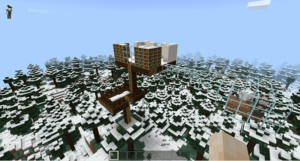Reflections on learning spaces
All throughout the course, I feel like I have learnt so much and in many different ways. In a general way, I have learned again what it is to study and exercise my brain in a very real sense. More specifically, I have learned to engage with study materials in this day and age, as they say, which has been quite different from my history degree 15 years ago when I studied using mostly books, not journal articles. Although there was multimodality then as well through pictures and artefacts and even a study trip to Tunisia to visit the ancient monuments left behind by the early Christians in the late Roman period. This course offers so much multimodality; the blogs, Twitter, videos of online lectures, MOOCs, drawing and Minecraft! (see the figure below) All of these give different insights into learning and have expanded my horizon.

One of the themes where I felt I learnt most, or perhaps where I feel like I had the biggest shift in thinking was the topic of Spaces and the impact technology has on them and vice versa. This is a particularly relevant topic at the moment with the pandemic and the resulting home schooling and working from home which has made everyone’s spaces more ‘fluid’ (Bayne et al. 2014). For this particular course and other online courses like it, the shift probably wasn’t as dramatic. I hadn’t really considered the expectations I had around learning spaces before IDEL started and I realized when the question of learning spaces came up that my thinking had been quite traditional; a classroom or lecture theatre, but experiencing online education during IDEL and creating a learning space in a game like Minecraft changed my perspective. Using Minecraft to create a learning space forced us to think about expectations for learning spaces in a creative way, but within the constraints of the game and using ‘Minecraft Expressionism’ (Flint et al. 2018). This is a great example of how spaces interact with learning and vice versa; using Minecraft shapes the way you think about the learning space because you have to think about it in that particular context. In the article by Mulcahy (2018) several examples of a learning space that students interact with are given. I found the one of the ‘Wellcome Hallway’ in Museum Victoria where an immersive video installation is created for people to interact with a fascinating idea. By showing people on screen and giving them a sometimes surprising dialogue, the museum has created a really thought provoking exhibit where the space interacts with the learners and vice versa (Mulcahy 2018). By creating this interaction between the visitors to the museum, or the learners you could say, something ‘radically new’ is created, along the lines of Biesta’s (2012) idea of what it is to teach.
Another interesting thing about the topic of learning spaces is the realisation that my learning takes place in so many different places and this clearly shows in the collage I made during week 7 as well as the data figure I created last week. A lot of my reflections on the materials take place away from my formal study place; this is maybe related to the type of course it is; if we were learning a practical skill, for instance, there would probably be less need for reflection.
Bayne, S., Gallagher, M.S., & Lamb, J. (2014). Being ‘at’ university: the social topologies of distance students. Higher Education, 67(5), pp. 569-583.
Biesta, G. (2012). Giving teaching back to education: responding to the disappearance of the teacher. Phenomenology & Practice, 6(2), pp. 35-49.
Flint, T., Hall, L., Stewart, F. & Hagan, D. (2018). Virtualizing the real: a virtual reality contemporary sculpture park for children. Digital Creativity, 29, pp. 191-20
Mulcahy, D. (2018). Assembling Spaces of Learning ‘In’ Museums and Schools: A Practice-Based Sociomaterial. In Ellis, R.A. & Goodyear, P. (Eds.). Spaces of Teaching and Learning: Integrating Perspectives on Research and Practice (pp13-30). Singapore: Springer.




Its great to finish with a meta reflection. Its good to read about the specific critical experience and how it changed your perspective on learning spaces and places. It would be interesting now, for you to experience a more traditional or skills based course to see if your experiences of learning and reflection were substantially different 🙂